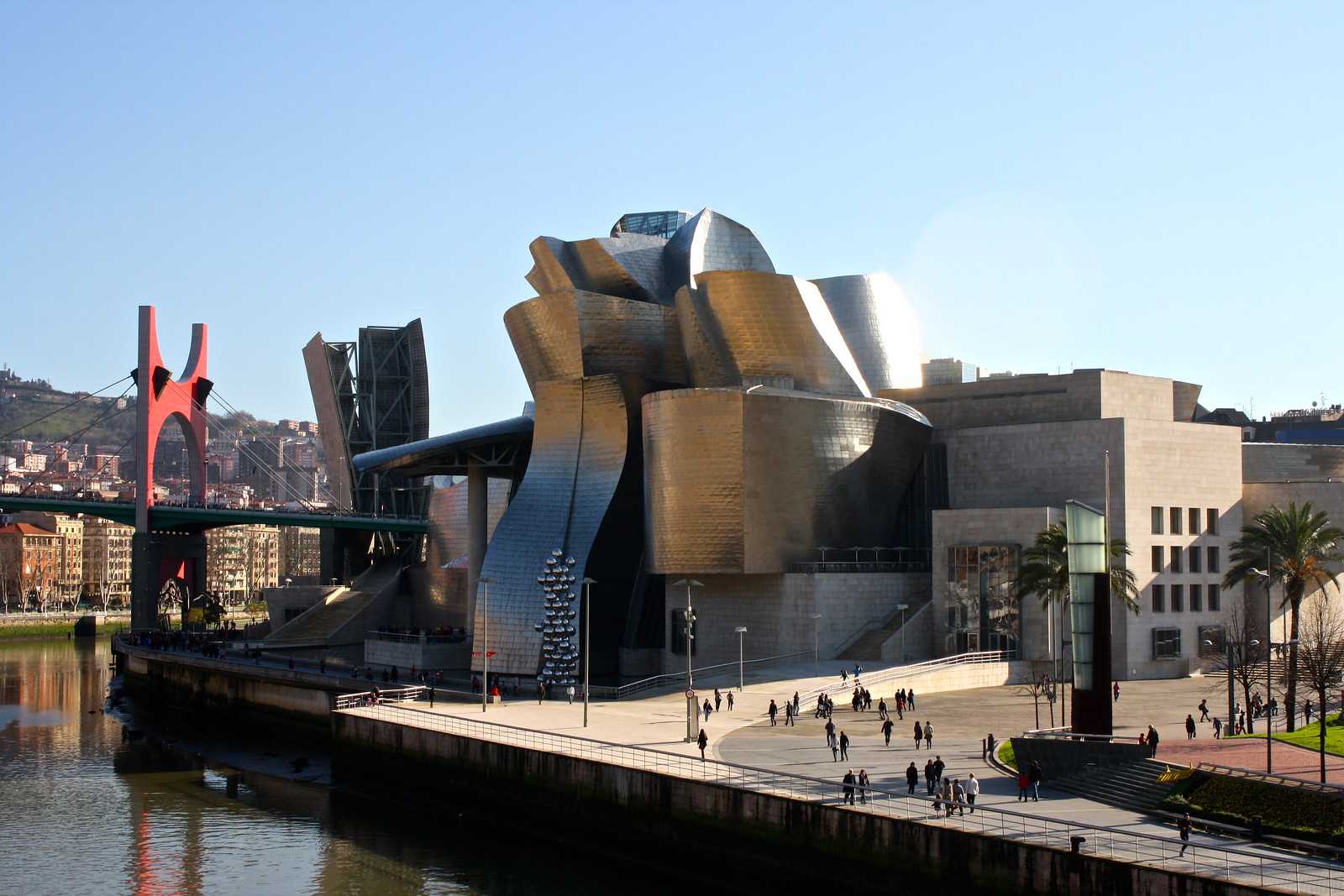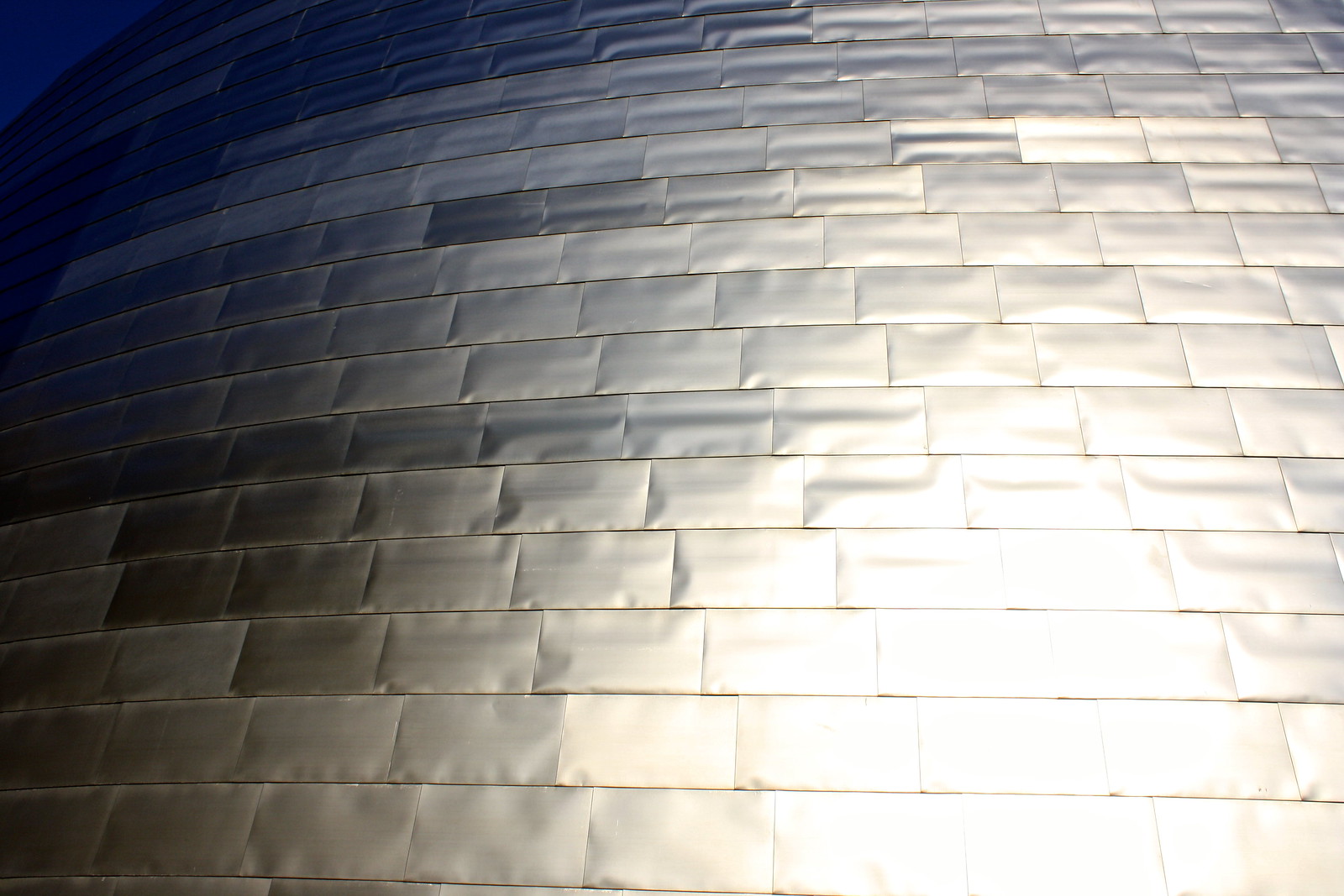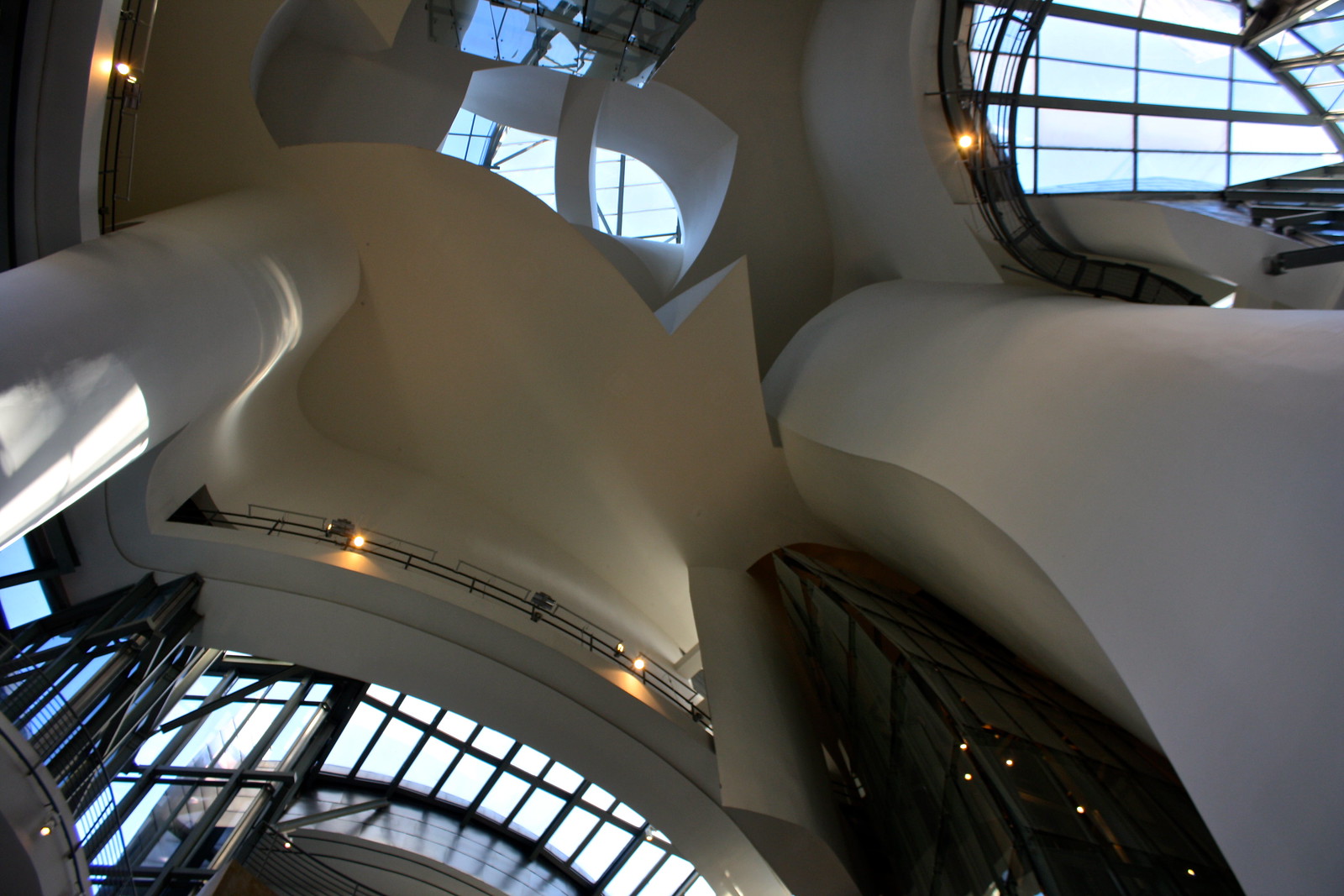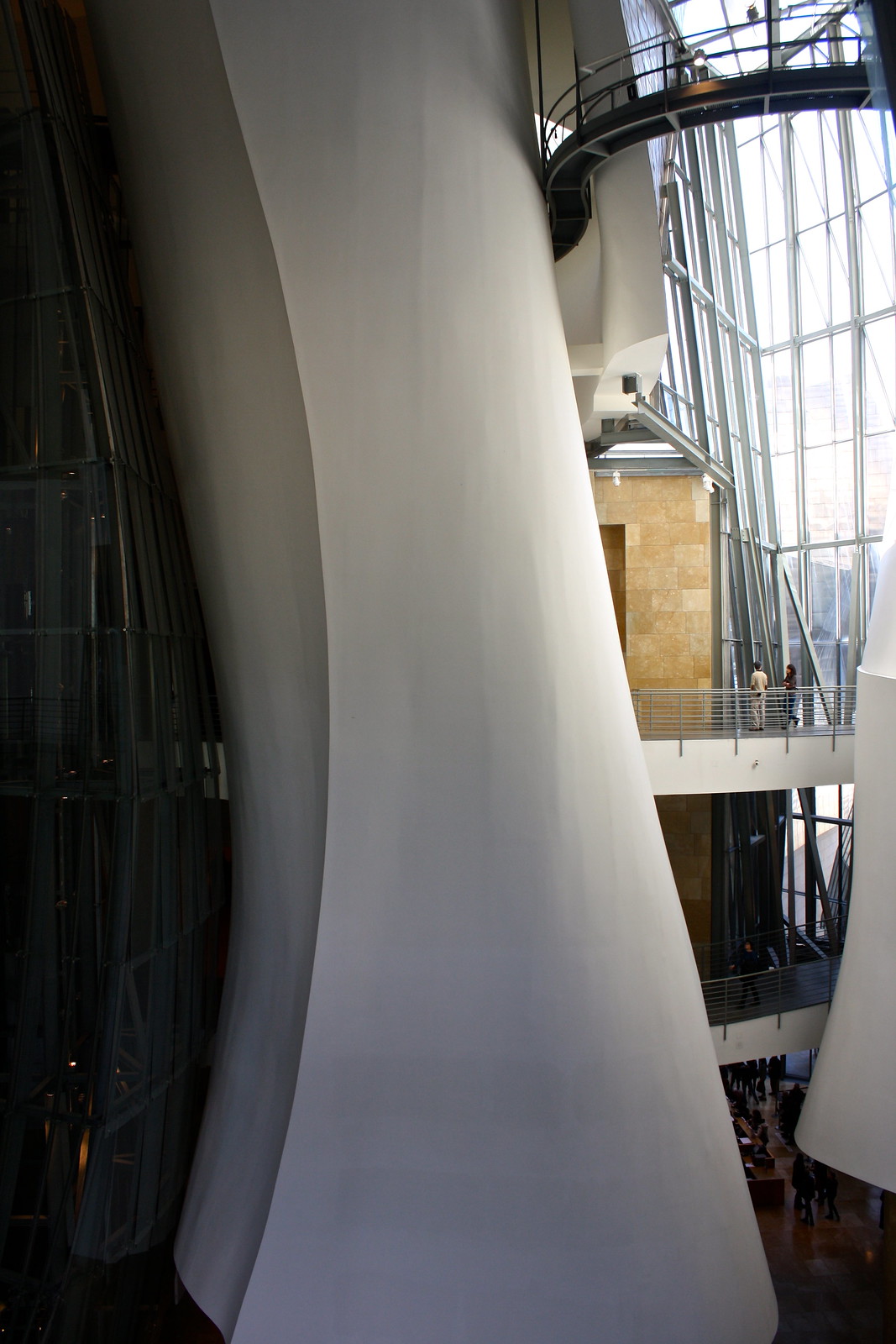Bilbao, Spain: Where the Modern Art Museum IS Art
On my return journey from France back into Spain, I stopped off for a few days in the Basque provinces in north-central Spain. In the short time I had to spend there, I fell in love with the coastal city of San Sebastián and decided to make a day-trip to nearby Bilbao, one hour to the west. Pronounced “beel-BAH-oe” [bil'βa.o], its name in the native Basque language is actually Bilbo—yes, spelled the same way as the protagonist from Tolkien’s Hobbit.
Nerd freak-out moment aside, Bilbao is a large city that stretches out between the hills and the Nervión River, a few kilometers inland from the coast. Although a lovely place to visit, its industrial, workaday heritage still shows through today. After all, Bilbao—along with the rest of the Basque Country—led the way in bringing the Industrial Revolution to Spain a couple hundred years ago. Blessed with large iron ore deposits and a strong population, the region quickly transformed itself over the span of a century in much the same way England did. This industrial past has often made tourists shun the city for the beaches of San Sebastián or the bullfighting culture in Pamplona, but Bilbao is still worth a visit if you’re passing through the region.
Short on time because of the disaster that was my New Years’ in strike-ridden southwestern France, I could only spend half a day in Bilbao, yet I still enjoyed the little I got to see.
I hate the whole notion of “must-see sights” when it comes to traveling, but in Bilbao’s case I have to give in and say that you absolutely cannot miss the town’s modern art museum. It isn’t necessarily the Guggenheim museum, but one of many scattered across the world, including that famous shell-shaped one in downtown New York designed by Frank Lloyd Wright. Other places sponsored by the Guggenheim Foundation can be found in Venice, Berlin, and Mumbai. In 1997, Bilbao’s opened in a space designed by architect Frank Gehry, whose work on the building itself overshadows the artwork it houses.
The building is the type of flowing, dynamic structure that could only have been achieved in the Information Age. From this technological perspective, you can appreciate the “walls” which take you back to those intersecting planes and waves from an intimidating trigonometry class. Builders were able to construct such precise, swooping curves with the help of modern graphing programs and have made an exciting departure from the limits of traditional architecture.
The museum’s collection holds numerous sculptures, but I believe the coolest one is the building that houses said collection—a sculpture that you can walk around, explore, and even touch with your hands. From the outside, its exhibition halls look like cubes of jello, frozen mid-wiggle, and from the inside, you get the feeling you’ve stepped into a futuristic gyrating cathedral.
Had Gehry designed this same museum anywhere else in the world, it would still be an amazing, fascinating work of art. But because this was to be a museum for Bilbao, for the Basque Country, the building holds much deeper significance.
The gleaming titanium panels that cover most of the structure evoke the region’s past connection with iron ore extraction and steel production, while at the same time reminding us of the iridescent scales of a fish. Fishing, and later whaling, played a huge role in Basque society for thousands of years.
The undulating walls and almost complete lack of straight edges connect the museum with the river and with the ocean. Centuries ago, Basque mariners had become experts at long-distance sailing and ship-building, and were found on famous voyages from Columbus to Magellan to the Spanish Armada. That Gehry connected his work with a sense of place in these ways makes his architecture all the more interesting.
After the Guggenheim, I hopped on the tram to the casco viejo. This “old quarter” is packed into a tight curve of the Nervión River much like the tinned anchovies you can buy at its corner grocery stores.
Like San Sebastián, Bilbao’s old town drew me mainly for its food (see the pintxos section below), which I wasted no time in taking advantage of. Pretty apartment complexes kept me shaded and cool as I went back and forth across a rigid street grid, something almost unheard-of in old European cities.
Also like San Sebastián, Bilbao has its own museum devoted to Basque society, called the Euskal Museoa. Thankfully it was free, but inside it was clearly a “free” museum; you could tell the exhibits and presentations were a little dated (not necessarily ugly, just kind of faded), HUGE blocks of text were really intimidating to plow through, and information was given exclusively in Spanish and Basque (no English or French at all). So if you don’t speak either of those two languages, you’ll be pretty lost here. It did surprise me to learn about the Basque diaspora: how countless Basques emigrated from Spain over the past two hundred years to places like the Argentine pampas or the mountains of the American West that reminded them of home. Apparently there’s a huge international Basque culture festival held every five years in Boise, Idaho. Who knew?
I give a better introduction to pintxos in my San Sebastián post, but to summarize, pintxos (also spelled pinchos elsewhere in Spain) are small, tasty two- to three-bite appetizers you can get at any bar or restaurant around the Basque provinces. To experience the epitome of the famous Basque cuisine, opt for a few pintxos spread out across an afternoon or evening instead of one heavy restaurant meal. It’s a fun, cheap way to get a broad feel for Basque cooking.
While in Bilbao, I tried the following pintxos:
How do you feel about modern “avant-garde” architecture like the Guggenheim museum: beautiful innovation or next decade’s laughingstock? And did you know there were so many Basque descendants abroad? Are you Basque? Join the comments below.

 |
| Riverfront apartments in Bilbao’s old town |
Nerd freak-out moment aside, Bilbao is a large city that stretches out between the hills and the Nervión River, a few kilometers inland from the coast. Although a lovely place to visit, its industrial, workaday heritage still shows through today. After all, Bilbao—along with the rest of the Basque Country—led the way in bringing the Industrial Revolution to Spain a couple hundred years ago. Blessed with large iron ore deposits and a strong population, the region quickly transformed itself over the span of a century in much the same way England did. This industrial past has often made tourists shun the city for the beaches of San Sebastián or the bullfighting culture in Pamplona, but Bilbao is still worth a visit if you’re passing through the region.
Short on time because of the disaster that was my New Years’ in strike-ridden southwestern France, I could only spend half a day in Bilbao, yet I still enjoyed the little I got to see.
The Guggenheim museum
 |
| The museum seen from the north |
I hate the whole notion of “must-see sights” when it comes to traveling, but in Bilbao’s case I have to give in and say that you absolutely cannot miss the town’s modern art museum. It isn’t necessarily the Guggenheim museum, but one of many scattered across the world, including that famous shell-shaped one in downtown New York designed by Frank Lloyd Wright. Other places sponsored by the Guggenheim Foundation can be found in Venice, Berlin, and Mumbai. In 1997, Bilbao’s opened in a space designed by architect Frank Gehry, whose work on the building itself overshadows the artwork it houses.
The building is the type of flowing, dynamic structure that could only have been achieved in the Information Age. From this technological perspective, you can appreciate the “walls” which take you back to those intersecting planes and waves from an intimidating trigonometry class. Builders were able to construct such precise, swooping curves with the help of modern graphing programs and have made an exciting departure from the limits of traditional architecture.
The museum’s collection holds numerous sculptures, but I believe the coolest one is the building that houses said collection—a sculpture that you can walk around, explore, and even touch with your hands. From the outside, its exhibition halls look like cubes of jello, frozen mid-wiggle, and from the inside, you get the feeling you’ve stepped into a futuristic gyrating cathedral.
 |
| Titanium panels |
Had Gehry designed this same museum anywhere else in the world, it would still be an amazing, fascinating work of art. But because this was to be a museum for Bilbao, for the Basque Country, the building holds much deeper significance.
The gleaming titanium panels that cover most of the structure evoke the region’s past connection with iron ore extraction and steel production, while at the same time reminding us of the iridescent scales of a fish. Fishing, and later whaling, played a huge role in Basque society for thousands of years.
The undulating walls and almost complete lack of straight edges connect the museum with the river and with the ocean. Centuries ago, Basque mariners had become experts at long-distance sailing and ship-building, and were found on famous voyages from Columbus to Magellan to the Spanish Armada. That Gehry connected his work with a sense of place in these ways makes his architecture all the more interesting.
The Basque museum
 |
| Atrium, Guggenheim museum |
After the Guggenheim, I hopped on the tram to the casco viejo. This “old quarter” is packed into a tight curve of the Nervión River much like the tinned anchovies you can buy at its corner grocery stores.
Like San Sebastián, Bilbao’s old town drew me mainly for its food (see the pintxos section below), which I wasted no time in taking advantage of. Pretty apartment complexes kept me shaded and cool as I went back and forth across a rigid street grid, something almost unheard-of in old European cities.
Also like San Sebastián, Bilbao has its own museum devoted to Basque society, called the Euskal Museoa. Thankfully it was free, but inside it was clearly a “free” museum; you could tell the exhibits and presentations were a little dated (not necessarily ugly, just kind of faded), HUGE blocks of text were really intimidating to plow through, and information was given exclusively in Spanish and Basque (no English or French at all). So if you don’t speak either of those two languages, you’ll be pretty lost here. It did surprise me to learn about the Basque diaspora: how countless Basques emigrated from Spain over the past two hundred years to places like the Argentine pampas or the mountains of the American West that reminded them of home. Apparently there’s a huge international Basque culture festival held every five years in Boise, Idaho. Who knew?
Pintxo count
 |
| Atrium, Guggenheim museum |
I give a better introduction to pintxos in my San Sebastián post, but to summarize, pintxos (also spelled pinchos elsewhere in Spain) are small, tasty two- to three-bite appetizers you can get at any bar or restaurant around the Basque provinces. To experience the epitome of the famous Basque cuisine, opt for a few pintxos spread out across an afternoon or evening instead of one heavy restaurant meal. It’s a fun, cheap way to get a broad feel for Basque cooking.
While in Bilbao, I tried the following pintxos:
- boquerones con pisto (pickled anchovies & ratatouille)
- crab sandwich
- solomillo Wellington (pork sirloin in a cheese sauce)
How do you feel about modern “avant-garde” architecture like the Guggenheim museum: beautiful innovation or next decade’s laughingstock? And did you know there were so many Basque descendants abroad? Are you Basque? Join the comments below.


